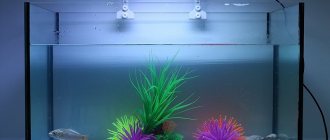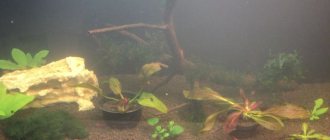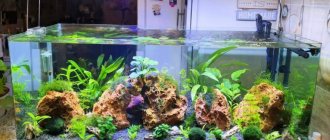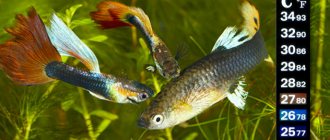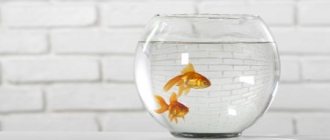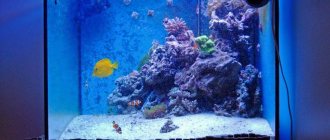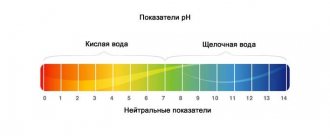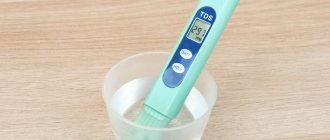Quickly navigate to the article
- 1 Optimal parameters
- 2 Temperature table for each type of fish
- 3 Temperature control methods
- 4 How to increase the temperature in an aquarium
- 5 How to lower the temperature in an aquarium 5.1 Other interesting articles
Fish are cold-blooded creatures, their body temperature is determined by the temperature indicators of the surrounding space. The activity and viability of the fish depends on the comfort of the water. When the permissible degree is lowered or exceeded, the likelihood of illnesses in pets increases, but sharp temperature fluctuations are even more dangerous. There are different methods for normalizing the water temperature in a fish aquarium.
What kind of water should be in the aquarium for betta fish?
Water for a betta must be pre-settled (tap water must be settled for at least one day, but it is best to settle water for an aquarium for three days). The normal water temperature for keeping males is required in the range of 26-30 degrees.
Interesting materials:
How long does it take to wait in line for the young family program? How long does it take to build a frame house? How long does it take to dry fruit? How long does it take to dry marshmallows in the dryer? How long does it take to heat a sauna in winter? How long does it take to heat a Russian bath? How long does hyacinth bloom? How long does it take to stew beets for borscht? How long does it take to cook minced meat? How long does it take to cook boletus mushrooms?
Optimal temperature for different species of fish
The most optimal temperature is considered to be between 22-28 degrees .
Lower values are acceptable, but within small limits. If the temperature drops sharply, this negatively affects the life of the fish. Most of them die.
There are also tropical fish species that are accustomed to higher rates. But this does not mean that the water should be excessively warm or hot. It is increased by 3-4 degrees, no more.
To understand which values are optimal, look at the temperature table for different types:
| Breed | Temperature, degrees | Maximum indicators, degrees |
| Parrot | 26-27 | 28 |
| Etroplus striped | 23-24 | 26 |
| Etroplus spotted | 21-24 | 25 |
| Akara turquoise | 24-27 | 28 |
| Apistogramma of a cockatoo | 21-26 | 28 |
| Apistogramma ramiresia | 23-26 | 27 |
| Astronotus | 21-26 | 28 |
| Astronotus oscar | 22-26 | 28 |
| Geophagus suriname | 23-27 | 28 |
| Common red discus | 27-31 | 32 |
| Discus green | 27-31 | 32 |
| Discus blue | 27-31 | 32 |
| Discus brown | 27-31 | 32 |
| Papiliochromis olive | 21-25 | 26 |
| Angelfish | 23-27 | 28 |
| Large angelfish | 234-27 | 28 |
| Golden angelfish | 23-27 | 28 |
| Marbled angelfish | 23-27 | 28 |
| Common angelfish | 22-27 | 28 |
| Torichthys | 21-26 | 27 |
| Cichlazoma Brilliant | 26-28 | 29 |
| Cichlazoma eight-banded | 20-24 | 26 |
| Heller's cichlasoma | 23-27 | 28 |
| Cichlazoma salvinia | 18-26 | 28 |
| Cichlazoma severum | 21-25 | 27 |
| Cichlazoma sejika | 21-25 | 26 |
| Cichlazoma Eliot | 18-25 | 26 |
| Cichlids of Africa | 23-27 | 28 |
| Aulonocara pink-blue | 24-25 | 26 |
| Dolphin blue | 23-27 | 28 |
| Iodotropheus | 23-27 | 28 |
| Red Cichlid | 23-27 | 28 |
| Labidochromis ceruleum yellow | 24-26 | 27 |
| Melanochromis golden | 24-26 | 27 |
| Pelvicachromis Kribensis | 23-25 | 26 |
| Princess of Burundi | 21-25 | 27 |
| Pseudotropheus zebra | 23-26 | 27 |
| Pseudotropheus lombardo | 23-26 | 27 |
| Telmatochromis dog | 23-26 | 27 |
| Frotonza, Queen of Tanganyika | 23-26 | 27 |
| Haplochromis burton | 24-25 | 26 |
| Chromis handsome | 23-27 | 28 |
| Julidochromis regan | 21-25 | 27 |
| Neon blue | 22-26 | 27 |
| Neon green | 21-25 | 27 |
| Neon red | 23-27 | 27 |
| Neon ordinary | 21-24 | 25 |
| Neon black | 23-26 | 27 |
| Gyrinocheilus | 21-27 | 28 |
| Girinocheilus golden | 23-25 | 26 |
| Bronze dianema | 21-27 | 28 |
| Band-tailed dianema | 21-27 | 28 |
| Corridoras blue | 19-25 | 26 |
| Corydoras golden | 18-24 | 25 |
| Mosaic corridor | 23-26 | 27 |
| Danio leopard | 17-24 | 25 |
| Danio rerio | 17-24 | 25 |
| Danio pink | 19-25 | 26 |
| Goldfish | 15-30 | 30 |
| Cockerels | 23-27 | 27 |
It is clear from the table that many fish can be combined with each other, depending on the temperature of the water.
The most unpretentious individuals are goldfish . Their thermoregulation is optimal for almost any conditions.
With your own hands
When deciding to make a water heater for an aquarium with your own hands, you need to take into account the risk of electric shock during its operation. Although many are able to make safe aquarium heaters.
For production you will need:
- resistance resistors;
- a piece of tube with thick walls;
- dry filler;
- durable thermostat.
Manufacturing scheme:
Don't forget to ask what the water temperature is now?
At what water temperature in an aquarium are there least problems? How to save fish when the temperature is too low or too high? This and much more is discussed here.
Find out right away:
At what temperature of water in an aquarium should aquarium fish be kept?
what to do if the water temperature in the aquarium drops sharply
what to do if the water temperature in the aquarium rises sharply
The water temperature in the aquarium has a direct impact on the well-being of fish, their activity, and ability to withstand diseases and adverse environmental factors. In water that is too cold for them, fish turn pale, take food less well, swim less, and in extreme cases they simply lie down on the bottom. If it is too warm, they begin to suffocate. The water in the aquarium is heated using immersion and flow-through heaters, as well as bottom thermal cords, or hydrocables (Hydrokable). For cooling, fans or special aquarium refrigerators are used, which are expensive devices, so aquarists rarely buy them. The need to lower the water temperature arises mainly in marine aquariums and herbal aquariums with strong lighting. A relatively inexpensive solution to this problem is to use branded aquarium fans, and a very cheap solution is to use computer fans. However, to install them on an aquarium with a lid-lamp, you will have to cut holes in the side surfaces of the lid. Fans cool the lamps and increase the evaporation of water from the aquarium, thereby lowering the temperature by 1 - 4°C. Much more often, aquarists have to heat the water. Hydraulic cables and flow heaters are still not widely used. But the immersion heater is an integral part of the aquarium equipment set. Once installed, the heater is often completely forgotten, because it maintains the set water temperature automatically 1) . However, the operation of the aquarium heater must be checked regularly using a thermometer, the readings of which should always be visible. In fact, the temperature of the water in the aquarium may differ markedly from that set on the heater, and then you will need to turn the thermostat knob in the right direction to achieve the desired result. In addition, the heater may break and then the water in the aquarium will cool down or, on the contrary, become too warm (not necessarily when it breaks, the heater stops heating, sometimes it just starts heating too much).
| Photo 1. Water heater for an Atman aquarium. These water heaters have a very durable bulb, which, as a rule, remains intact when you forget to turn off the device from the network during a water change. Unfortunately, this happens to me quite often. But I can’t remember the aquarium overheating due to a failed thermostat. |
So, both too cold and too warm water are dangerous for aquarium fish. Cold, perhaps, even less than overheated, because fish can suffocate when overheated much faster than die from cold.
But, most importantly: fish do not like rapid changes in the temperature of the water in the aquarium! In addition, beneficial bacteria that ensure biological balance in the aquarium do not like rapid changes in temperature 2).
At first glance, this may seem strange, because the aquarium is inhabited by cold-blooded creatures: their body temperature is the same as the temperature of the surrounding water 3) . Scientifically speaking, fish are poikilothermic animals. They do not need to spend energy to maintain a constant temperature of their body, so the fish will not shiver from the cold, nor will they sweat from the heat. Then why and how is water that is not the right temperature dangerous for them? The fact is that aquarium fish mainly come from the tropics, where the water temperature in winter and summer differs very little. Therefore, their metabolism is tuned to a fairly narrow temperature range. In other words, aquarium fish best absorb food, develop, and resist pathogens in a limited temperature range. As scientists say, these are stenothermic fish.
In natural reservoirs, seasonal and daily fluctuations in water temperature are distinguished. Even if seasonal temperature fluctuations in the historical homeland of a certain aquarium fish do occur (in the tropics, seasonal fluctuations in water temperature are not well expressed everywhere and this depends on the climate characteristics of the region), then the range of these fluctuations is incomparably narrower than in our temperate latitudes, and the change water temperature in a natural reservoir occurs slowly. Therefore, fish adapt well to a gradual change in temperature if it spans several days, or even weeks, but not hours . Daily temperature changes, as their name suggests, occur quickly: within a day. But due to the high heat capacity of water in a large reservoir, they are insignificant and usually do not exceed 2-3°C. At night the water cools down a little. An aquarium is incomparably smaller than a natural reservoir, so it can cool down by 3-5°C (or even more!), or overheat within just a few hours if the temperature in the room where the aquarium is installed suddenly drops or rises quickly. The smaller the aquarium, the faster the water temperature can change. This is especially important to remember for owners of the currently fashionable nano-aquariums. Another reason for a sharp jump in temperature in the aquarium can be a water change. Do not put too cold or too warm water into the aquarium. Those who like to take water changes directly from the tap (without settling) should be especially careful in winter, when the tap water is very cold: 8°C or less. Rapid changes in aquarium water temperature are unnatural for tropical aquarium fish and they negatively affect their immunity. If there is no thermometer in the aquarium, temperature fluctuations may go unnoticed by the owner. And he will only be surprised at the various fish ailments that appear “out of nowhere.” As a rule, sudden cooling causes ichthyophthyriosis or chylodonellosis, but it is quite possible that other diseases, for example, bacterial septicemia, may occur.
With gradual adaptation, some aquarium fish (zebrafish, thoracatum catfish, speckled catfish, guppies, not to mention goldfish, which are eurythermic 4) ) can adapt to a decrease in temperature by 10 or even 15 ° C. Those aquarists who take their pets “to the dacha” in the summer and place them in a garden pond are well aware of this. From mid-August in our latitudes, the water begins to cool a little, but the fish can live outside until September, and even catch part of September if the autumn is warm. It goes without saying that a successful stay of fish in an open reservoir is possible only if they are free from pathogens, otherwise during the period of adaptation to new country conditions or during a cold spell they will certainly get sick. The ability of aquarium fish to adapt can also explain the discrepancy in reference publications regarding the optimal temperature for keeping a particular species. Typically, the earlier a book is published, the lower these temperatures are. For example, one cannot but be surprised by the information provided by N.F. Zolotnitsky in his fundamental work “The Amateur’s Aquarium,” written at the turn of the 19th and 20th centuries. The values indicated there are very low according to our current understanding. Thus, according to Zolotnitsky, lalius can withstand 12°C, and spawns as soon as the water temperature in the aquarium begins to exceed 21°C. This is due to the fact that heating water in an aquarium in those days was not an easy task. For the most part, the water temperature in indoor reservoirs was truly “room temperature”, and in winter in houses with stove heating it was not hot - about 19°C 5) . In such conditions, those fish survived that could adapt to them. For the generations that appeared in the aquarium, the specified temperature regime was already “native”. It should be noted here that there are fish that cannot be “persuaded” to live at low temperatures. These are, for example, discus fish, freshwater stingrays, altums, and uaru. In the natural biotopes of these fish, the water almost always has a temperature of 27-34°C. Another thing is lalius, whose habitat covers the northern regions of India, where in winter the water temperature can actually drop to 12°C.
However, let's return to the current state of affairs in the aquarium hobby. Nowadays, most of the fish sold in pet stores come from farms in Vietnam, Thailand, Malaysia, Ceylon, Indonesia, and Singapore. And it's warm there all year round. So the fish that arrived from there prefer rather warm water. At the very least, adaptation to aquarium keeping (they are grown in pools and ponds) should take place at temperatures of 27-28°C, and then live in aquariums at a temperature of 25-26°C. In this temperature range, the adaptive capabilities of fish, their resistance to stress, and their ability to resist pathogens will be maximum. You will find out why this is so by reading this material to the end.
| Video 1. These are the conditions in which fish grow on a Malayan farm. The water here is very warm 29-30°C. The breeder strives in every possible way to saturate it with oxygen, and in this he is deeply right. Agree, after such a comfortable existence, it will be very difficult to adapt to life in an aquarium. True, an exemplary farm is presented here. In others, the conditions are worse, but everywhere the fish live in very shallow bodies of water, in the water of which a lot of oxygen is dissolved. Therefore, the indispensable conditions for successful adaptation will be the correct choice of water temperature in the aquarium, its maximum saturation with oxygen and a low content of nitrogenous substances. |
In an aquarium with labyrinth fish (these are gouramis, bettas, laliuses), which largely breathe atmospheric air, it is necessary to control not only the water temperature, but also the air temperature above the water. Labyrinth fish can get sick or even die by “breathing” air that is 3–5°C colder than the water where they live. Therefore, when keeping these fish in an aquarium without a lid-lamp, some caution when ventilating the room where the aquarium is located is especially necessary.
What to do if the water temperature in the aquarium suddenly drops?
First you need to establish the cause of this fall: close the open window, replace the broken heater. If you don’t have a spare heater at hand, provide additional heating to the room and let a plastic bottle filled with warm water float in the aquarium. You can’t let a bottle float in a nano-aquarium, since the water from it will overflow, but you can lean a plastic bag with warm water against the wall of the aquarium. Having achieved a temperature rise of 2-3°C, it is necessary to assess the condition of the fish. If they begin to gain color and swim confidently (without loss of coordination), then nothing more needs to be done. But if they continue to lie on the bottom (which happens if the aquarium has cooled down very much), then you will have to take emergency measures to revive them: pouring cognac or vodka into the aquarium in an amount of 30 ml/100 l has a healing effect. The fish will begin to swim in 10 - 15 minutes. 24-48 hours after adding alcohol to the aquarium, cloudiness of the water and the formation of mucus on the glass and leaves of plants may begin, which is not dangerous for the fish, but it certainly will not decorate the aquarium. To prevent cloudiness, you should, without waiting for it to occur, filter the water through activated carbon or replace a third of the volume of water. You will have to work hard, but you will save the fish. How else can you heat the water in an aquarium if you don’t have a working heater at hand? Maybe the pictures from old books below will inspire DIY enthusiasts to get creative, but it would still be better to purchase a new aquarium heater as soon as possible. A separate article will soon be written on Aquarium about how to choose the right aquarium heater based on the volume of the aquarium and its contents.
| Here are drawings from old aquarium books (“Indoor Aquarium” - ed. M.A. Peshkov, Moscow University Publishing House, 1961 and “Aquarium Fish Breeding” - M.N. Ilyin, Moscow University Publishing House, 1977), from which you can see How can you heat an aquarium if you don’t have a branded aquarium heater at hand? All these devices are far from safe. Using the first two may cause cracks in the glass of the aquarium if the heating is too strong, and the next two may result in electric shock. |
Overheating an aquarium can be even more dangerous for aquarium fish than cooling it down. The fact is that as the temperature rises, the metabolic rate of fish increases significantly, which means the need for oxygen also increases. Well-fed fish especially need oxygen. But here’s the problem: the solubility of oxygen in water decreases with increasing temperature. As a result, the fish begin to suffocate and may die from asphyxia.
| The solubility of oxygen in water decreases with increasing temperature. It can be seen that at 30°C, half as much oxygen can dissolve in water as at 0°C. No matter how good the water aeration is, at 30°C only 7.63 mg/l of oxygen can be dissolved in the aquarium water. I note that testing water for oxygen content in real-life aquariums showed a much lower oxygen content. As a rule, unless the aquarium is a “herbal” with “bubbling” plants, the oxygen content in it, even with good aeration, does not exceed 5 mg/l. And this is at a temperature of 25°C, not 30°C! The graph is based on data from the book by V.I. Lukyanenko. “Ecological aspects of ichthyotoxicology”, Moscow, 1987 |
The most common cause of overheating is the failure of the aquarium heater, which continues to heat and heat, despite the fact that the set temperature has long been reached and exceeded. In addition, possible causes of overheating may be direct sunlight entering the aquarium and thermal radiation from heating radiators (if the aquarium is located too close to them) when the heating season suddenly begins.
What should you do if there is a sharp rise in temperature in the aquarium (overheating of the aquarium) and the fish float sluggishly near the surface, gasping for air?
If the aquarium overheats, it is necessary to increase aeration to the maximum possible. If the pump of your aquarium filter allows air to be sucked in, which is then thrown out along with a stream of water, be sure to turn on this mode! Remove the lid from the aquarium and let a plastic bottle of cold water float in the water. In the first 10 minutes you can reduce the temperature by 2°C, in the next 20 – by another 1-2°C. If the compressor is low-power and does not allow for increased aeration, and there is no pump, or its design does not allow aeration of the water, then continuously shake the surface of the aquarium water, at least by hand. Any stirring of water enriches it with oxygen! If, despite all the measures taken, the fish continue to swim very sluggishly at the surface and breathe heavily, then add pharmaceutical grade (3%) hydrogen peroxide to the aquarium water at the rate of 20-25 ml per 100 liters. Hydrogen peroxide, once in an aquarium, quickly breaks down into oxygen and water. This is an environmentally friendly substance and in the indicated doses will not harm the fish at all. Long-stemmed plants (cabomba, pinnates) may suffer from a dosage of 25 ml per 100 liters or more, but the fish will be saved. In addition, in the indicated dosage, hydrogen peroxide is a good preventative antiparasitic, antifungal and antibacterial agent. However, peroxide should not be used in an aquarium with shrimp .
What water temperature should be considered dangerous for aquarium fish?
When talking about the water temperature being too high for fish, I did not indicate what temperature it was. And this is no coincidence. The maximum maximum water temperature that a fish can still tolerate depends not only on its species, but also on the temperature at which it was kept before the temperature jump. For example, goldfish adapted to temperatures of 28 – 29°C can tolerate a short-term increase in the water temperature in the aquarium to 41°C, but for fish adapted to 15°C, a rise in temperature to 41°C will be fatal. In general, for most aquarium fish that live for a long time at a temperature of 25 ° C, heating the water to 32 degrees C or more will be dangerous. This circumstance must be taken into account when treating fish by increasing the water temperature.
What should the temperature of the water in the aquarium be?
I already noted above that the optimal water temperature for keeping most aquarium fish is 25-26°C. Why not 28-30°C, like on the farms where these fish are raised? After all, at “usual” temperatures one would expect maximum resistance of fish to diseases. However, in reality, the water temperature in the aquarium should be lower. Why? To answer this question, compare the conditions of keeping fish on a farm and in an aquarium. Water in shallow farm pools (see Video 1) is typically near maximally oxygenated (about 7 mg/L at 30°C), but most indoor aquariums only contain 5 mg/L oxygen even at 25°C. or even less. And this is with fairly intense aeration. Only the water of herbal aquariums, where carbon dioxide is supplied, can be extremely saturated with oxygen, but even there their own problems arise that limit the water temperature. A rise in the water temperature in the aquarium will cause an increase in oxygen deficiency, which is very harmful for fish and greatly reduces their resistance to pathogens. In this regard, exceeding the threshold of 26°C, unless effective measures are taken to maximize the saturation of water with oxygen (for example, installing an oxidizer), will cause more harm to the fish than good. But it is not only oxygen deficiency that limits water temperature. The accumulation of nitrates and phosphates in amateur aquariums is an almost inevitable phenomenon. The toxicity of these, and all other pollutants in aquarium water (and there may also be ammonia, nitrites, and sometimes even traces of hydrogen sulfide in the aquarium) increases with increasing water temperature. So it turns out that raising the temperature of the water in the aquarium results in an increased toxic effect on the fish. What could this lead to? To the development of diseases typical for aquarium fish: mycobacteriosis and hexamitosis and a reduction in the lifespan of fish. Aquarium plants also grow best in this temperature range; more about the optimal water temperature for plants is covered in another article.
Aquarium water temperature and fish behavior.
Water temperature influences fish activity and behavior, which can be used to reduce the amount of digging that many South American cichlids do and reduce aggressiveness. As a rule, reducing the temperature in the aquarium by 2 - 3°C promotes calmer behavior of dominant fish, which in cool water are less likely to attack their neighbors. Some cichlids, preparing a place for laying eggs, heavily dig up the soil. This activity can radically change the appearance of the aquarium, which is not always pleasant for the aquarist. As the water temperature drops, the intensity of excavation decreases. The water temperature should be reduced gradually: by 1-2°C per day. In most cases, 23°C will be the limit value below which the temperature should not be lowered.
Aquarium water temperature and treatment of aquarium fish.
It is widely believed that if the fish are sick, you need to raise the water temperature - this will help the treatment. Wait, don't rush. We already know that the oxygen content in water decreases with increasing temperature, so if the symptoms of the disease manifest themselves as oxygen starvation, then the temperature cannot be raised. Also, you cannot raise the water temperature if the content of nitrates and phosphates in the aquarium is high and if the maximum concentration limit for total ammonia and nitrites is exceeded. Therefore, hyperthermic treatment of fish can be carried out only when water quality indicators are close to ideal.
The influence of water temperature in the aquarium on sex determination in fish.
The mechanisms of sex determination in fish are varied and depend not only on genetic factors. For some species, the temperature of the water at which the embryo and larvae develop plays an important role. The following pattern can be observed for them: the higher the temperature, the more males are produced.
| The number of male fish increases with increasing water temperature at which eggs and larvae develop. This pattern is true for some types of aquarium fish, for example, for different types of apistograms, for zebrafish and for swordtails. Details here (in English). |
When is heating needed?
The water in the aquarium is constantly affected by environmental factors. These are direct sunlight, air temperature.
Living organisms (fish, algae) live inside, releasing metabolic products. Therefore, the temperature regime gradually changes.
If this happens by 1-3 degrees, there is no need to heat the water . Fish are able to survive in different temperature ranges.
When a person frequently ventilates a room or leaves it in a draft, the water quickly cools. The temperature may drop below 18-20 degrees if it is a cold season outside. In these cases, heating is required. It is recommended to first check the temperature with a thermometer or electronic thermometer.
How to control the temperature indicator?
If the temperature in the aquarium drops sharply, this will negatively affect its inhabitants. Some of them may die.
Therefore, it is recommended to install a high-quality thermometer that will indicate to the user the temperature of the water. If it decreases significantly, heating techniques can be used.
The most optimal method is to use a device that not only measures, but also heats water. You just need to set the required temperature. Then you won’t have to constantly monitor the indicator.
Heater power
When choosing the power of the device, you need to rely on the instructions for use. Immediately tell the salesperson in the store what the displacement of your aquarium is. The degree of water heating depends on the power.
There is a golden rule for calculating power, according to which there is 1 liter per 1 W of power. water. Some manufacturers indicate other parameters, so you should still check the instructions.
Table for selecting the power of the heating system by tank volume:
| Power, W | Tank volume, liters |
| 25 | 10-25 |
| 50 | 30-50 |
| 75 | 45-75 |
| 100 | 60-100 |
| 150 | 90-150 |
| 200 | 130-200 |
| 300 | 230-300 |

